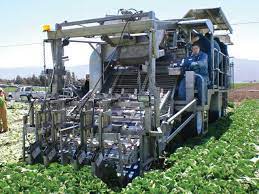The following are the major factors affecting mechanized harvesting of field crops;
1. Cropping and Farming Systems
Previous analyses of the cropping and farming systems are required to determine the actual needs regarding mechanization. Location of the land under cultivation, intensification level, prices of products, etc. are some important factors to be considered.
The mechanization of the harvesting operation for crops – mainly food crops – with yields ranging between 0.5 and 2 tons per hectare rarely justifies itself economically.
On the other hand, mechanizing the harvesting operation will be more easily justified on an intensified irrigated area of several hectares with paddy rice as main crop, where small farmers can group together, and the sale price for paddy is sufficiently attractive.
2. Cropping Conditions
The constraints affecting harvesting and threshing operations which influence the quality of the product are:
The moisture content of the grain at harvest time;
The maturity of the crop;
The type of plant involved;
The way it stands in the field.
The moisture content of the grain at harvest time
The moisture content of the grain must be between 18 and 23% at harvest time, or between 12 and 20% at the threshing stage.
These guidelines determine the start of operations. Below such values, losses (in the case of rice) from shattering during harvest and breakage during threshing are excessively high and bad for the subsequent processing.
Above such values, problems arise at storage level: risks of moulds developing and germination of the grain in stores, drying cribs or granaries.
3. The Crop Maturity
Crop maturity and type directly affect mechanization and vice versa. The introduction of mechanized technology has reduced the tendency to plant mixed varieties of grain: single variety crops ripen uniformly thus making it easier to harvest or thresh them mechanically.
With crops which do not mature at one time, the choice of the date for performing the harvesting operation will determine the results: for paddy an earlier harvest will generally result in low yields and high percentage of unripe grain; on the other hand, delayed harvesting will lead to shattering losses, higher percentage of broken grain at the processing level, etc.
In addition, the weed infestation level will affect the use of machines and also the cleanliness of the harvested and threshed materials.
Read Also : Methods of Harvesting and Processing of Field Crops
4. The Type of Crop Involved
The type of plant influences both the choice of machines and their performance:

The grain-straw ratio must be as high as possible to limit the volume of straw entering the machine;
The attachment of the grains to the panicles or spikes must allow relatively easy stripping at maturity;
Erect and short stemmed varieties are preferred (paddy varieties with very curved grain ears make it necessary to cut high proportions of straw, and tall varieties of maize, millet and sorghum prove difficult to mechanize);
The abrasive property of certain seeds (e.g., paddy) makes it necessary to use high quality materials in the manufacture of machines.
To meet these objectives, it is necessary to observe a very strict work schedule, especially for wetland paddy.
Accordingly, machines must be able to work under particularly difficult conditions: in the mud with special attachments (tracks, cage-wheels, etc.) before the complete drainage of rice fields, at low working speeds, on a produce difficult to cut being still partially green, and handling of a product often soiled with mud.
5. Social and Labour Constraints
Harvesting is a labour-intensive operation but is less arduous than threshing. Because most of the rural population consider threshing as a particularly tedious operation (especially in the case of millet), grain producers accept the relatively high cost of mechanical threshing.
The skills and experience of farmers, and the interests of traditional systems, must necessarily be taken into account when mechanising certain operations.
It will be easier to extend the use of harvesting machines where farmers are already employing other powered equipment such as tractors, motor pumps or processing units.
The availability of workers skilled in the operation, maintenance and repair of engine-powered equipment favours the adoption of new machines.
Lastly, in developing countries harvesting and threshing operations are traditionally carried out by women. However, in most situations, as these operations become mechanised, they are taken over by men and the role of women is reduced to winnowing and the gleaning of grain scattered during harvesting and threshing.
The mechanisation of post- harvest operations frequently means the transfer of activities from women to men.
6. Economic Constraints
Economic constraints are a drawback to the purchase of farm machinery. The high costs involved, above individual farmers’ resources, allow the acquisition of such equipment only if credit and the possibility of farmers grouping together exist.
Alternatively, if private individuals are interested in equipping themselves, they can hire out their services to the rest of the community.
To justify and encourage the purchase of machines, technical versatility can be an incentive (e.g. a rice thresher which can also be used for threshing millet and maize), even if the equipment proves less efficient with certain crops than a specific single-purpose one.
In such a case, the choice of the equipment should be made according to the crop which is mechanized first. In practice, the costs of machines and services vary from one country to another.
Read Also : Concept and Principles of Water Quality
